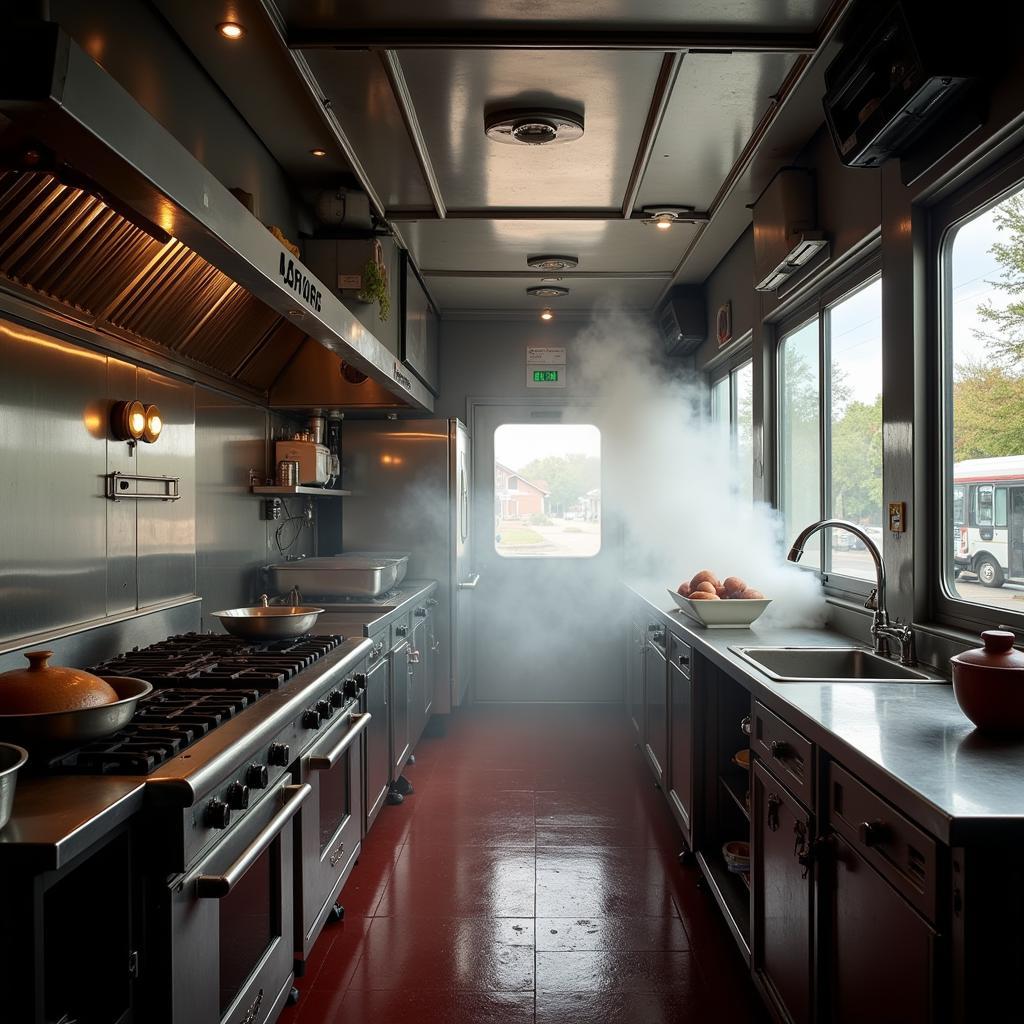A successful food truck is a delicious paradox. It’s a tight, mobile kitchen serving up big flavors and even bigger dreams. But crammed within those vibrant walls is a complex operation requiring meticulous planning, especially when it comes to ventilation. A food truck ventilation fan is not just a regulatory requirement; it’s the unsung hero ensuring your culinary creations don’t get lost in a cloud of smoke and grease.
Breathing Easy: Why Your Food Truck Needs Proper Ventilation
Imagine this: you’re in the weeds on a busy Friday night, the sizzle of grilling patties mingles with the aroma of frying onions, and orders are flying in faster than you can shout “Next!”. This dream scenario can quickly turn into a nightmare without proper ventilation.
 Food Truck Kitchen Ventilation
Food Truck Kitchen Ventilation
Here’s why a good ventilation system for food truck is non-negotiable:
- Smoke and Odor Control: This is a no-brainer. Cooking generates smoke and odors that can be overpowering in a confined space. A food truck range hood paired with a powerful fan effectively removes these, ensuring a comfortable environment for you and your customers.
- Temperature Regulation: The heat from grills, ovens, and fryers can turn your truck into a sauna. A well-designed ventilation system helps regulate the temperature, preventing equipment malfunction and creating a bearable workspace.
- Safety First: Proper ventilation is crucial for removing dangerous airborne grease, fumes, and combustion byproducts, protecting your health and preventing fire hazards.
- Compliance and Permits: Most local authorities have strict regulations regarding food truck ventilation. Installing a compliant system ensures you can operate legally and safely.
Choosing the Right Ventilation Fan: Finding Your Perfect Match
Selecting the right food truck oven is one thing, but choosing the perfect ventilation fan is a whole other ball game. With a dizzying array of options available, consider these factors:
- Fan Type: Axial fans are compact and budget-friendly, suitable for smaller setups. Centrifugal fans, while pricier, offer higher pressure and efficiency, ideal for larger trucks or those with high-volume cooking.
- CFM Rating: CFM (Cubic Feet per Minute) indicates the fan’s airflow capacity. The larger your truck and the more cooking you do, the higher the CFM you’ll need.
- Noise Level: Nobody wants a deafening roar competing with their culinary creations. Opt for fans with lower decibel ratings, especially if you’re in a noise-sensitive area.
- Energy Efficiency: Look for energy-efficient models to minimize your operating costs.
“Don’t underestimate the importance of a well-ventilated kitchen,” advises Chef Michael, owner of the popular “Rolling Bistro” food truck. “It impacts not just the food quality but also the well-being of your team and the success of your business.”
Maintenance Matters: Keeping the Air Flowing
A low profile exhaust fan for food truck is a worthwhile investment, but like any other equipment, it requires regular maintenance to function optimally:
- Regular Cleaning: Grease build-up is inevitable. Clean your fan blades, filters, and hood regularly to prevent clogging and maintain airflow.
- Inspection and Repair: Periodically inspect your system for wear and tear. Replace worn-out parts promptly to prevent costly breakdowns.
- Professional Servicing: Consider scheduling professional maintenance checks to ensure everything is in top shape.
Fresh Air, Fresh Start: Investing in Your Culinary Journey
A Food Truck Ventilation Fan might seem like a small detail in the grand scheme of your mobile culinary venture. However, it’s a crucial investment that significantly impacts the quality of your food, the comfort of your workspace, and ultimately, the success of your business.
Remember, a well-ventilated kitchen is a happy and productive kitchen. And that, my friends, is a recipe for success.
FAQs about Food Truck Ventilation Fans
1. What size ventilation fan do I need for my food truck?
The size depends on your truck’s dimensions and cooking equipment. Consult a professional to determine the appropriate CFM rating for your specific needs.
2. Can I install a food truck ventilation fan myself?
While possible, it’s recommended to hire a qualified technician to ensure proper installation and compliance with safety regulations.
3. How often should I clean my food truck ventilation fan?
Cleaning frequency depends on usage. Aim for at least monthly cleaning for filters and quarterly cleaning for blades and hoods.
4. What are some signs that my ventilation fan needs repair?
Unusual noises, excessive vibration, reduced airflow, and visible damage are signs that your fan might require professional attention.
5. Are there energy-efficient options for food truck ventilation fans?
Yes, look for fans with high energy-efficiency ratings to minimize your energy consumption and operating costs.
Need help choosing the right ventilation fan for your food truck? Contact us at Phone Number: 02437655121, Email: minacones@gmail.com Or visit our address: 3PGH+8R9, ĐT70A, thôn Trung, Bắc Từ Liêm, Hà Nội, Việt Nam. Our dedicated customer support team is available 24/7 to assist you. You can also explore our wide range of food trucks for sale in CT.